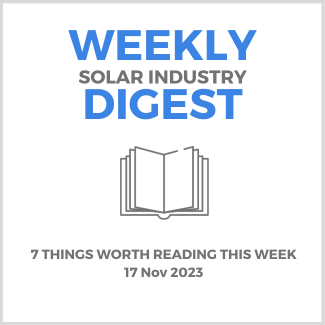The US International Trade Commission held a hearing on tariffs on silicon cells that was attended by SEIA and manufacturers QCells, Silfab, Heliene, Suniva, First Solar, and Canadian Solar. SEIA testified that the tariff rate quotas on imported cells should be raised significantly while some manufacturers argued that it be removed entirely or also raised significantly. First Solar and Suniva did not request changes, saying safeguards were working as they should.
Solar Builder has unleashed its 2024 storage buyer’s guide. It rounds up offerings for the resi and commercial markets from legacy PV inverter and module brands, off-grid and portable power providers moving into grid-tied markets, and smart home and high-end consumer electronic companies expanding into power and energy management.
DMEGC Solar, a manufacturer of high-efficiency photovoltaic modules, released two N-type rectangular wafer module series. They are called M10RT and G12RT and enable mass production efficiencies of up to 25.5% and use Super-Multiple Busbar tech plus high-density packaging. The company points to the fact that the improvements make them very effective in low-light conditions.
A FERC commissioner publicly stated that if utility regulators don’t force transmission owners to use grid-enhancing tech, they won’t do it. This kind of tech includes dynamic line ratings that use sensors to monitor transmission lines plus power-flow control devices and analytical tools. The commissioner also referenced the idea that regulators could help transmission owners overcome barriers to adopting this tech.
The U.S. Geological Survey and the DOE’s Lawrence Berkeley National Laboratory have released a single, interactive map that tracks all large-scale solar energy facilities in the country. Called the USPVDB Viewer, the map is based on the U.S. Large-Scale Solar Photovoltaic Database.
4 industry insiders discuss their spin on the post-NEM 3.0 California rooftop solar market, and how energy storage will need to play an increasingly important role. They talk about how much resi solar is being hammered now and the repercussions plus forces that could counteract market retraction such as rising electricity prices and double inflation. They critique the fact that NEM 3.0 hasn’t fulfilled its promise to help boost BESS – and more.
In this Solar Conversation, Jon Bonanno of SolarAcademy talks with Nalin Agarwal, co-managing director of the Climate Seeds Fund and founding partner of Climate Collective based in India. Nalin shares his journey into the clean energy sector, starting from his undergraduate studies and transitioning to renewable energy due to his interest in machines and the development sector. He talks about his decision to return to India after being inspired by a group of passionate individuals and his work in project development in the renewable energy sector. Nalin and Jon also discuss the expansion of their initiative beyond the EU’s borders to South Asia. They highlighted the importance of entrepreneurship in the climate tech sector and investment trends among family offices and institutional players. They also talk about the operations of their venture capital fund and the various accelerators run by the Collective. They conclude the conversation by discussing the potential for machine learning in climate solutions. The video is below.

